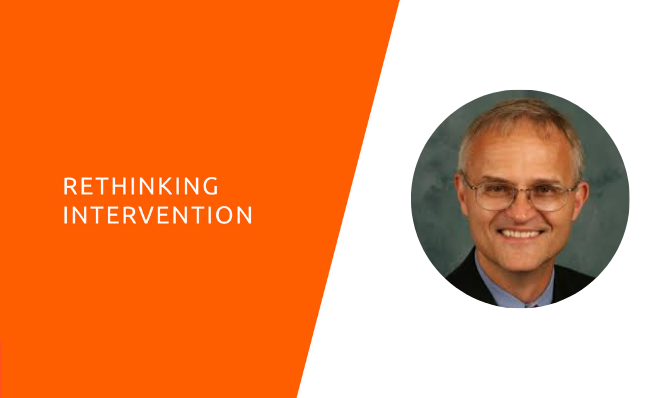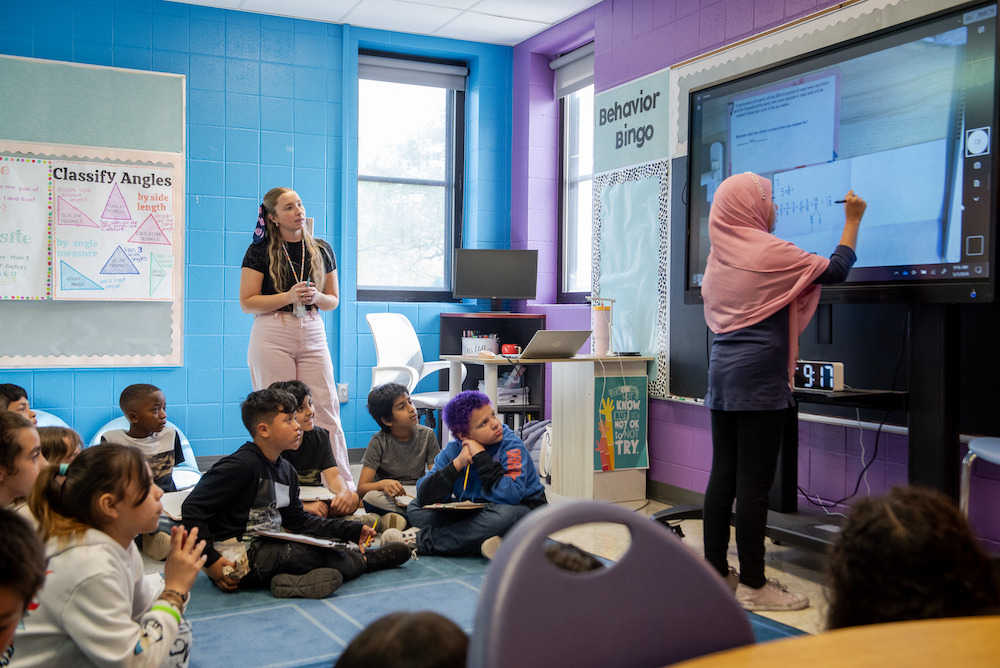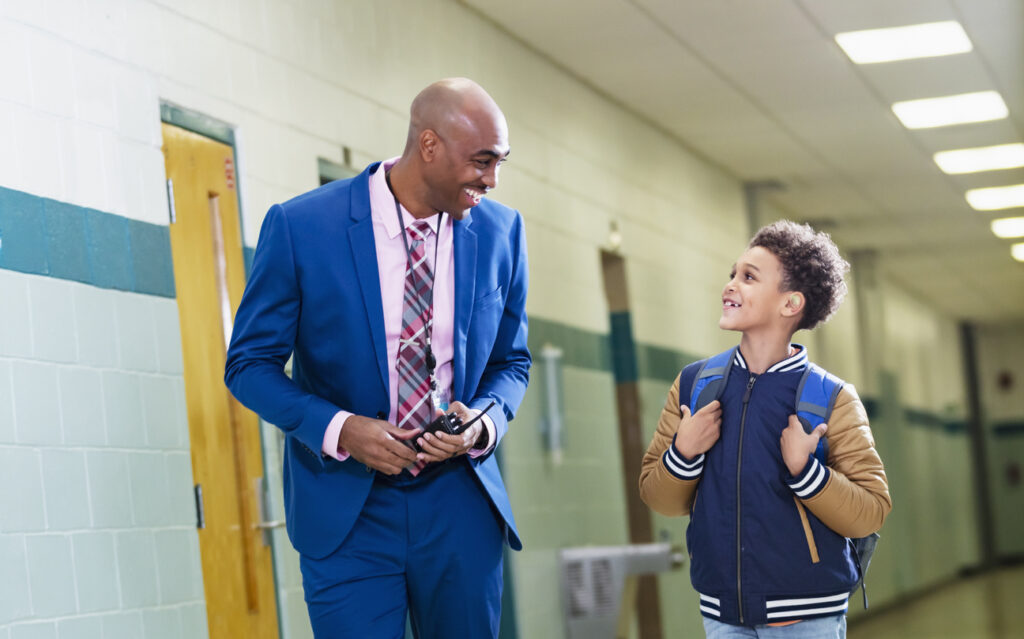
Bror Saxberg, Chan Zuckerberg Initiative
Dr. Bror Saxberg is the head of learning sciences at the Chan Zuckerberg Initiative (CZI). Dr. Saxberg spoke to Emily Freitag about the importance of understanding and building on students’ strengths and experiences to create safe learning environments and motivate student learning.
Watch the full conversation or read the abridged Q&A below.

EF: Please share a story from your journey as a learner, and what that has informed about your perspective on learning.
BS: Very early on, I got into trouble when I was in first grade because of my handwriting and I was nearly held back from advancing to second grade. I literally could not make interpretable characters on one line. I was the last kid in the whole grade who was still working on two lines. The school policy was you should be held back if you cannot make interpretable characters on a single line in first grade. My teacher just absolutely went to bat and she got them to recognize this is the dumbest rule and got me instead engaged with a gifted and talented program and off I went. Over many years, I have repeatedly run into barriers because of my handwriting. It was another teacher, an English teacher in high school, who saved me there. Imagine this: they had a faculty meeting at my high school around, “What are we going to do about Bror’s handwriting?” I didn’t hear about this meeting until long after I graduated from high school. And it was Dr. Judy Lightfoot who got up at the meeting and said, “This is ridiculous. This is a meaningless conversation. I can read his writing just fine. If any of you are having problems reading his writing, you bring it to me and I will read it out loud to you.” Then, when I was in Oxford trying to pass my exams, I got a call from the bursar at my college who said, “Mr. Saxberg, you’re going to have to stay an extra few weeks because we don’t believe we can read your handwriting on these mathematics exams. And we’re going to have you spend time with a scribe and a policeman to make sure you don’t cheat as you read out what you actually wrote.” They actually managed to figure it out, and I didn’t have to do that. But I’ve had so many experiences where people really were ready to hold me back because of my handwriting. One more example was in second grade the teacher had a little exercise she wanted us all to do. We all gave her the written sentences and she handed back her feedback, except to me. Then she called me up to her desk and she said, “I can’t read this.” And I thought to myself, in second grade, “Here we go again.” And she said, “I’ll make a deal with you. If you agree to make a verbal presentation to the class every week instead of writing a few sentences every week, I will get what I want, which is that you communicate, and I don’t have to read your handwriting.” So I gave a little talk every week. And that was how it worked.
EF: What did it make you think about yourself?
BS: Nothing at the time, because all these different teachers intervened in a way that did not communicate to me that I was a loser. I really didn’t even know in first grade that Mrs. Hutton had to go to bat for me to get me to second grade. I found out about that years later. And in second grade, it was just a conversation, it wasn’t a big deal. Years and years later, as I began to engage in how we think about learning and advancement and personalization, I realized I am literally the product of a dozen years of adaptive education by incredibly talented educators who intervened, not just substantively, but also from an identity perspective. It was because of those interventions over all those years that I was actually able to succeed and prosper, even though I had, according to many teachers, a real deficit. It never came across to me that way. It was more like, “We’ll handle it with you.” It comes from things like Todd Rose’s idea of how everyone is a mix of things that they’re good at, things they are not so good at, things that they’re kind of average at, and the real key is how you take advantage of what people are good at without stumbling over the things that might actually be quite difficult for them. Looking back on my academic journey, I realized that pretty much accidentally, I managed to have teachers who were really good at helping me get over those problems that I had without having been delayed from a content standpoint or from an identity standpoint. It was never communicated to me that I was bad at learning because of the mechanics of my handwriting. Part of what motivates me is that going forward, that shouldn’t be accidental. That should be intentional. Every student should have the benefit of teachers with the expertise and understanding to help achieve their potential while maximizing what they’re good at and working around the things they’re not so good at.
It is complicated because one of the things about learning and teaching is that if the student is not good at something, shouldn’t we spend a lot of time bringing them up to standard? There’s a real tension between that and spending the time to let students accelerate based on what they’re actually really good at. And I’m not saying there’s a simple answer at all.
EF: Tell me, from your research and your experience, what approaches work?
BS: What’s fun about research is it often validates things that good teachers have known for millennia. It’s not like this blinding insight about jumping up and down on your left foot while closing your right eye and how it helps with understanding fractions. Some of the key stuff that is so powerful and engaging are things like how the non-academic and the academic are completely tied together. You cannot separate these things. You have to think about a student’s emotional state and you have to think about their own identity as they walk into a subject before you can get to the mustering of cognitive effort required to do complex cognitive tasks that we all want students to actually become good at. Especially now when we think about the pandemic and students coming back, it’s a mistake to think that because we are so behind academically, that we have to focus exclusively and only on the academic side, because that’s just not how minds are built. If a student comes in thinking, “I’m no good at math,” you really have to address that right upfront. Because otherwise, it’s really hard for that student to start, persist, and put in mental effort into things around learning math. It’s a very simple thing that comes out of some of Carol Dweck’s work—this idea of, you’re not good at it yet, so let’s face the reality. It’s not that you are good at it and you just didn’t realize it, it’s that you’re not there yet. But there is work to be done, and if you do it we can get you there. Similarly, storytelling about others who’ve been in your position and how they also dug in and got going, and were able to make progress. All of these things then start to help students recognize, “I can do this.”
Another really important issue that comes out of relatively recent work over the last 10 or 15 years are these ideas about the impact of toxic stress on learning. It’s profound and fundamental. It’s at a neurochemical level that the hormone cortisol is released when you are under continuous stress. When you’re continuously flooding your learning systems with cortisol, it actually gets in the way of the neurochemistry of learning. As students come back and have been in very stressful conditions, you really have to think about how we can lower those stress levels. How do we help them have a sense of belonging in this place with these other students? How do we get them to empathize with each other? And how do we help the teachers to recognize what students are going through?
Often the teachers and the students are coming from very different cultures. Having teachers begin to open up to understand the complex experience of a student coming back, and that is not the same as your experience or your children’s experience as a teacher, is incredibly important to then be able to work with that student. Make use of their context, make use of their assets, make use of their strengths, and recognize we’ve got to make this a safe space for every one of those students who are coming back. It’s not a moral question, it’s not a question of ethics, it’s not a question of culture, it’s literally a question of chemistry. If the stress molecules are not actually addressed as students are able to find their school to be a safe, comfortable environment for learning.
There are also important elements about how you really have to spend more time on practice and feedback. That is, if you’re spending 60–70% of class time with a teacher broadcasting, you are missing what most students need. Teachers should be broadcasting 20% or less, and students should be practicing and getting feedback for 70% or 80% of the time in order to run their brains. It’s when your brain runs that it actually starts to submit things. Hearing is important to get a sense of information, maybe the start of motivation. But what really matters for learning is practice and feedback. And that’s as true for nonacademic skills as it is for academics.
We try pretty hard to have learning progressions in mathematics or reading or writing. Our analysis and work on non-academic skills are often not nearly as systematic. Teachers are often not nearly as well prepared to recognize levels at which students are on non-academic skills and non-academic capacities, nor are they as well prepared to figure out what are the activities they need to construct or create within the environment that allows students to begin to build their non-academic capacities, whether it’s executive function or social and emotional interactions and empathy and communication skills, or identity issues. We’re not getting our teachers enough help with how to resolve those issues. And they really are important to get into if you want your students as a whole to succeed.
EF: Let’s flip to talking about what we try that we know actually doesn’t work. This comes from a very urgent place of wanting to make sure that the treatment to exacerbated inequity doesn’t lead to furthering that very inequity. What do you worry we’re going to do that we actually have evidence does not work?
BS: One of the things that I worry a lot about is that teachers and administrators in a panic over their yearly state test results and the professional consequences of those will think that the right answer is to dive immediately and rapidly into a whole variety of drilling away at academic tasks. It’s coming from a place of wishing the best for students, but I think it’s missing the multi-dimensional perspective of human development, which says the non-academic and the academic are so tied together and you cannot separate these things. If you do not spend some time really settling the culture of your school, making students comfortable in their skins in their classes, and having teachers begin to develop some sensitivities to the different experiences and cultures of students compared to their own—if you don’t do that, you run the risk of basically, bulldozing, depending on the class, 20–50% of your students, while trying hard to accelerate the 30% of students who you happen to know well, and who happen to have the same culture that you do or have happened to have had a very reasonable experience through what’s been happening over the last few months. There was an example in Houston after a hurricane that a school that was closed for one or two months. Everyone came back and the school leadership just said, “We’re going to spend two weeks getting to know each other again. That’s all we’re going to do. We’re just going to talk to each other. What has happened to your family? Let us understand each other. And then we’ll get back to work.” They had the biggest test score gains that year of any year they’ve ever been involved. That was after months of literally being wiped out and in the middle of all the stress. That investment in saying, “Let’s get everybody together. Let’s make it into an empathetic group of learners who look after each other. And then let’s get going.” It made an enormous difference. So I think that’s one of the risks.
There are a number of other kinds of risks. People are well-meaning, but things like learning styles. This notion that kids can be kind of bucketed into kinesthetic or verbal or visual or whatever it is. The research shows very clearly that brains do not “bucket.” You need many different routes for complex topics. Sometimes the visual approach doesn’t work for a kid, but the auditory approach does. You need many different ways of doing things, especially things that are hard. But there is not a pattern. It’s not like it works the same way for a kid all the way along.
The other risk is this challenge of helping teachers increasingly get students to engage, to practice, to produce, and then get the feedback. That feedback can come from the teachers and can also come from peers. With the right scaffolding, peers can actually be pretty good feedback engines for each other. That notion of really looking to see if you are giving students enough space and time to produce and struggle is a very important thing to actually look for.


